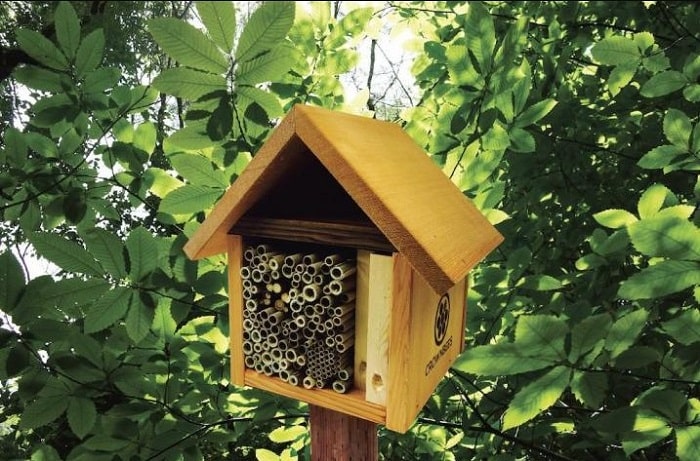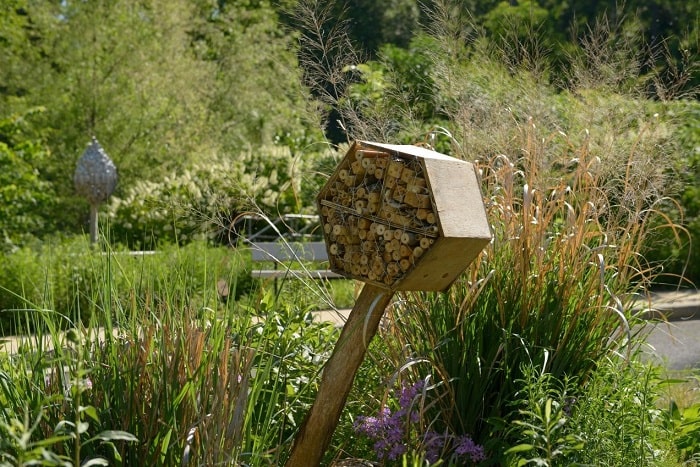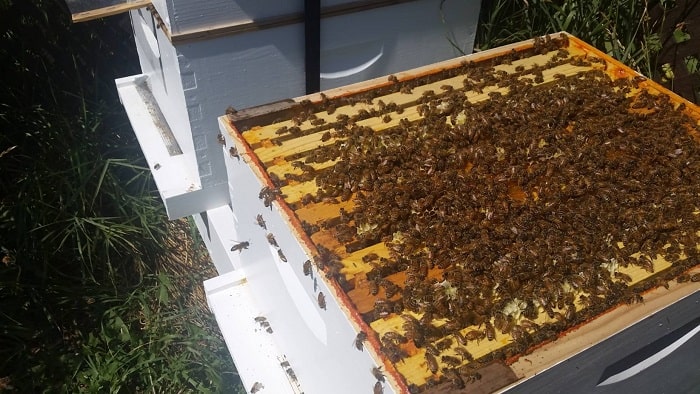Spring is almost here. Do you have any plans for your garden? If not, you can think about a bee house. They are beneficial whether you grow fruits and vegetables or just grow flowers. Beehives and bee houses are not the same thing. Honey bees live in beehives to collect honey, whereas solitary bees live in bee houses. Solitary bees do not produce honey, yet they are great pollinators. In today’s article we will share with you how to attract bees to the bee house.
Why have a bee house?
We all know how vital bees are to the world because of their unrivaled pollination abilities. However, not all bees are the same. Some enjoy the swarming. Some enjoy the stinging. Unlike bee boxes, bee houses are designed specifically for Mason bees, which are great pollinators who rarely sting and spend relatively solitary lives.
So, one of the main reasons people want to build bee houses is for pollination. While honey bees are well-known pollinators, Mason bees are 120 times more effective at pollination than honey bees. As a result, farmers frequently use Mason bees as commercial pollinators.
Native bees, like honey bees, are experiencing a significant population reduction. In fact, approximately 40% of native bee species in the United States are on the verge of extinction. Planting pesticide-free pollinator gardens and offering bee houses for shelter are two ways we may help native bees fight back.

What types of bees are drawn to a bee house?
Before “breaking ground” on a DIY bee house, you must first decide who will live in your bee homes and bee hotels. Here’s a quick list of some of the most prevalent and enjoyable species, not to mention their activity patterns:
-
Carpenter bees
Carpenter bees are just like any other busy bee. They prefer to reside in decaying tree trunks and dead branches. These hardworking bees chew their way through the wood, creating tunnels as they go. Carpenter bees store food, lay eggs, and spend the winter hiding out in their small tunnel system.
Female Carpenter bees can sting if threatened, while males have no stingers at all. Remember that most bees sting because they are either threatened or trying to protect a colony. And Carpenter bees do not have a colony to protect.
-
Mining bees
Mining bees spend their time underground building enormous tunnels in which to lay their eggs. One advantage of living amongst other Mining bees is that they appear to be a vast colony, posing a threat to predators.
Mining bees can sting, but they are also placid bees with little motive to sting unless they are threatened. The mining bee is a wonderful pollinator.
-
Mason bees
Because of their ability to fertilize fruit plants, Mason bees are popular among orchard owners. The Mason bee is frequently utilized in commercial orchard operations to increase tree pollination. So, if you want to start an orchard, this could be the perfect single bee to attract.
Mason bees prefer to live in abandoned nests left by other species of solitary bees, making them easier to attract. They are eager to move into a DIY bee house and begin interior decorating as soon as possible.
-
Leafcutter bees
They are well-known for cutting circular sections of leaves and using them to construct their nests. Leafcutter bees, like Mason bees, are excellent pollinators and rarely sting. Pollination of alfalfa, blueberries, carrots, and onions is a favorite of Leafcutter bees.

>>> Read more: How to Build a Langstroth Beehive Box – 10-frame and 8-frame
How to attract bees to a bee house?
-
Provide proper housing
The first step in attracting bees to your garden is to give them a good place to live. You can build your own house or buy a ready-made one. The most significant issue is to use the appropriate size nesting tubes for the type of bee you are attracting.
Mason bees prefer nesting tubes with a diameter of 8 mm, whereas leafcutter bees prefer nesting tubes with a diameter of 6 mm. Furthermore, your bee house should be positioned in a predator-free region that is protected from wind, rain, and direct sunshine.
-
Plant a pollinator garden
A pollinator garden is an excellent technique to draw bees to a bee house. This is due to the fact that pollen and nectar from flowers are an important food source for bees. If you want to attract leafcutter bees, you should also have plants that they like to use for nesting, such as roses and azaleas.
-
Provide a mud source
Mason bees need mud to build their nests, therefore if you have a good mud source nearby, Mason bees are more likely to visit. Some people obtain this by digging a hole in the earth and filling it with water.
If you do not have enough dirt to make a mud source, you can use a mud mix. Mason Bee Mud Mix delivers the appropriate moist, clay-like mud for Mason bees.
-
Attractant spray
InvitaBee Attractant Spray attracts bees to your bee house by employing Mason or leafcutter bee aroma pheromones. Spray it onto the front of the nesting house. This spray does not ensure that bees will stay at your location, but it does increase the likelihood that they will.
-
Buy cocoons
Buying Mason or leafcutter bee cocoons is an alternative to attempting to attract bees to your bee house. When the weather warms up enough, the cocoons will be placed in the bee house. The bees will hatch and choose a nesting hole in which to lay their eggs.

>>> Read more: What To Do After Catching A Swarm Of Bees?
Types of DIY bee houses that attract bees
The following DIY bee houses are easy to make and are suitable for most solitary bees.
-
Bamboo bee house
All you need is a background. You can use anything you can find that can comfortably hold a handful of bamboo sticks, such as PVC pipes, old wooden boxes, etc. You should close one end of the bamboo tunnel and try to keep each bamboo the same size. When you have completed your bee house, hang it somewhere sunny, facing south, and at least 4 feet from the ground.
Carpenter bees and Mason bees will be attracted to this kind of DIY bee house, and you may find more than one species living in it.
-
Wood bee house
A wooden bee house works similarly to a bamboo house. You can use a basic woodcut or old stumps to build a house. If you want, you can dress up your wooden bee house with trim. When you are done with your house, hang them in the same position as the bamboo house.
-
Pallet bee hotel
Pallets are ideal for various types of bees since they may handle a wide range of design components. Each layer can include a different material, such as a wood box home, cinder blocks, straw, old wooden logs with holes punched into them, or even clay bee houses.
-
Sod bee house
If you have been waiting to learn about the greatest Mining bee hotel, here’s your DIY Bee house blueprint. Layers of sod should be stacked with the dirt facing up. Select a wildflower mixture to plant directly on top of the sod stack. The layers of dirt and wildflowers will drawn Mining bees into your garden.
Conclusion
A bee house in your yard is a pleasant family pastime that also benefits native bees. To attract bees to a bee house, give appropriate housing, a mud source, a pollinator garden, and an attractant spray. You can also be a good host by building a DIY bee house for your local solitary bees.
>>> Read more: Best Honey Extractors Review 2021 – Manual And Electric Options
